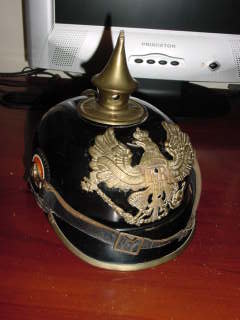
Kit Helmets
Joseph P. Robinson.
28 September 2005. May 2018
Collectors have spent a lot of time trying to determine how helmets flowed into the units. Several years ago, few collectors understood it at all. But today, serious collectors understand the Bekleidungsamt markings on helmets is the vehicle that let us to study where helmets came from and how they were issued. There are still lots of holes and misunderstanding. Just as you thought, you understood a great deal of it another picture surfaces and throws you a curve ball. This is a series of two pictures that have created great discussions. These pictures were not taken at the same time but in the same place of roughly the same group of people. They were both sent by Heinrich Hölzer. These individuals are from the Helmmacher Abteilung of XIV Corps. XIV Corps was the corps of Baden troops in the Prussian army. The helmets that they are proudly displaying are metal ersatz helmets. For lack of a better description these were “kits”. The helmet shell was factory produced as well as separate front visor, rear visor, liner, spike assembly, rear spine, cockades and chin strap and wappen. These separate components were then “snapped” into place by an assembly organization — by this Helmmacher Abteilung. This unit outlived its purpose with the introduction of the M15 helmet. However, when they were in demand, a man could snap together a helmet fairly easily.
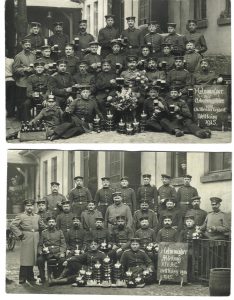
In peacetime, pre-war Germany equipment was issued by Army Corps. Each Corps had a small but very important supply unit called the Bekleidungsamt (BKA). Consider them clothing depots. Pictures of the BKA and the BJA(repair outfit) focus on sewing machines and often times civilian workers. The BKA was not standard in size or organization but varied by Corps and nationality. In some cases civilians populated the “handwerk” section. Prussian Corps had about 75 NCO and OR types while Bavarians had 200. Wurttemberg’s Corps and the two Saxon Corps had 28 NCOs but no ORs each.
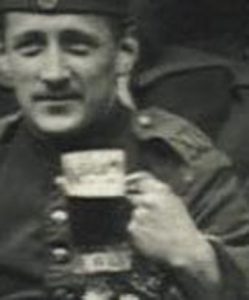
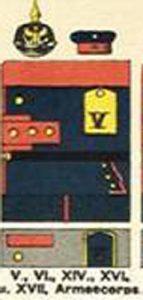
The uniforms of the Bekleidungsamt were very specific. These pictures show a mixture of uniforms as was common for recruits. They use the old blue uniforms for training. It looks like some troops behind the lines use these also for daily activities.

The shoulder of strap and sleeve decorations in the pictures seem to match the XIV Corps Bekleidungsamt. This makes immense sense, but the words Helmmacher Abteilung is a new one.
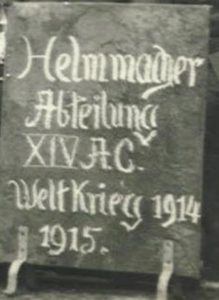
The gentlemen in the second photo were obviously gathered for a birthday party of Head Master Gebhart. (Obermeister translated as “head master” has nothing to do with schools. The term Obermeister denotes the chief craftsman of a guild, usually. He was a respected master craftsman of the region and elected to this office. In this case, though, he will have been the most senior master craftsman of the Abteilung of the Bekleidungsamt or maybe even of the whole Bekleidungsamt.–Klaas Dierks). You can plainly read the cancellation mark of the first of March 1915 in Baden on the other card. You’ll notice that there are both Prussian and Baden wappen on these new helmets. Why? There is a mention of Gren Reg. 110 on one of the cards.
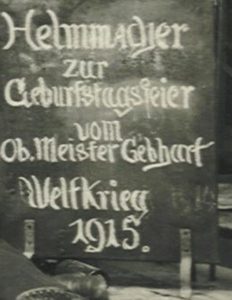
You’ll also notice on the bottom shelf, there are five helmet forms. The center three are liners that have not been dyed. The outer two are shells without the visors attached. These are helmet forms ready to be assembled. There is no clear explanation yet of the mix of wappens.
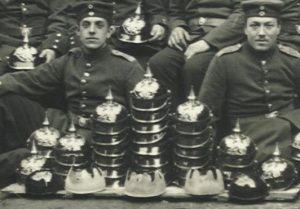
Before we examine the helmets in detail. We will look at the back of the cards.
our translation comes courtesy of a member of AHF.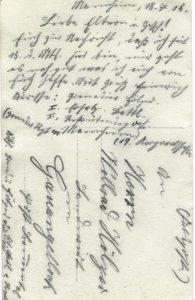
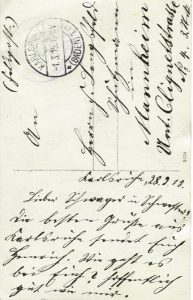
This first picture holds few surprises. A postcard to his brother in law from Heinrich Hölzer dated clearly1 March 1915 addressed:
To
Mr. F. Lengsfeld
policeman
in Mannheim
Lower (Untere) Clignet street
No.4, 3rd floor
Karlsruhe, February 28th, 1915
Dear Brother in law and Sister!
Dearest Greetings from
Karlsruhe sends
Heinrich. How are
you both? Hopefully
as well as I am.
This is consistent. Heinrich Hölzer from the BKA sends a postcard showing his unit that puts together ersatz helmets. The second picture says roughly.
Mannheim, the 18th of July 1915
Dear Parents and siblings
Jus to let you know that I have been since the 15th of that month here,
I am still well, and the same for you I hope.
With greetings, Heinrich
Adresse: Grenadier Hölzer
I. Ersatz.Battl.
I. Rekrutendepot
(Grenadier Rgt. 110 Mannheim)
(19. Korporalschaft)
The gentelman who helped translate this card added this note: “That man’s handwriting is very “special”. I fear he is that farmers son and not very used to writing.” The card is addressed to:
To Mr.
Volkrad Hölzer
Farmer
in
Gauangelbach
Post Bammertal [“m” with bar means “mm”; south east of Heidelberg]
From:
Abs. Grenadier Hölzer 1. ErsBattl. 1. Rekr.
Rgt 110.
It seems reasonable that this unit’s mission ended with the arrival of the M15 helmet. In this case, it seems as though grenadier Holzer was sent to Grenadier Regiment, 110.
An example of a Kit Metal Helmet
The helmets themselves are a thing of simplicity. This example shows a complete helmet with the spike removed. There were 13 pieces to this helmet. These 13 pieces could be assembled by hand in the order of one through 13. The Helmmacher Abteilung provided the hands.
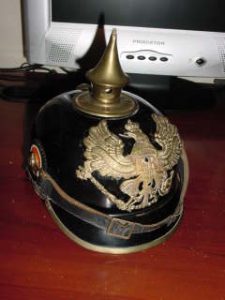 |
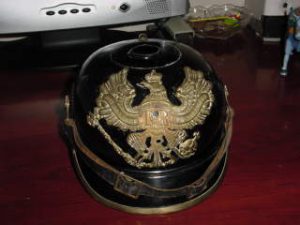 |
- The helmet body or bell made out of thin steel and covered with black enamel paint. The outer covering a shiny, black and reminiscent of the enamelware used on some mess tins. There were factory made holes in the bell for the spike, the wappen, the spine and the M91 posts. This was pressed out of one piece of steel. There was a ridge around the base of the bell to allow for the placement of the liner and the front and rear visors. The hole on top for the spike, had a raised flange edge. The wappen hole was unique in that there was a rectangle and two circular holes. The rectangular hole was for the wappen to fit through, and the circular holes, which are close together, could possibly have been for a Saxon or Mecklenburg plate like the example on the right below.
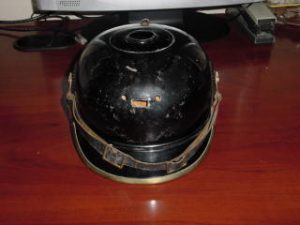 |
 |
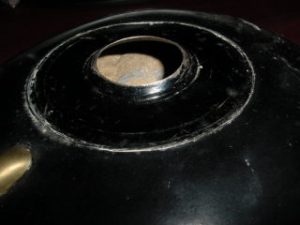 |
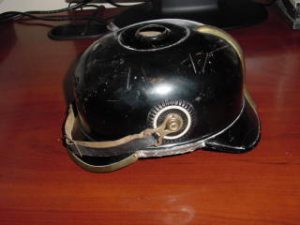 |
2&3. Two M91 posts. These were standard design to accommodate a 1 mm thick side hook. These were placed in the holes and the rear prongs bent to keep the posts in position.
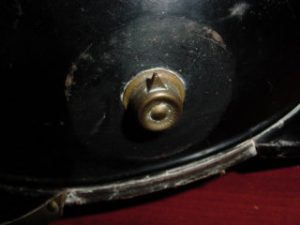 |
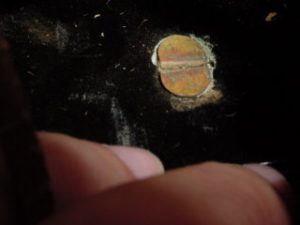 |
- The liner made of very thin leather or a paper leather combination. These liners were deeper than the normal liner and had a split in the back. This split was fixed through the use of a snap. This example has the female end of the snap, but the male end is gone. The liner was laid on to the bell and crimped into the side ridges.
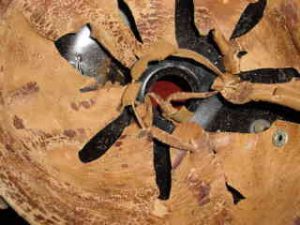 |
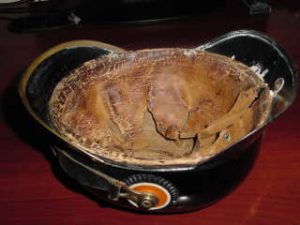 |
- The front visor made out of thin steel factory issued with a brass visor trim and faux brads on the corners. The faux brads are quite small with the exception of Saxon ones which approximate mormal size. In this example, the maker’s mark is engraved on the inside of front visor. The visor was placed into the ridges on the bell, and then bent down into position, holding the liner in place and the visors securely to the bell. The company was Firma von der Heyden in Berlin who also produced the first 50 metallhelmes for Bavaria.
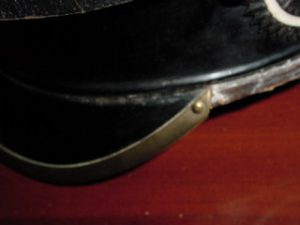 |
 |
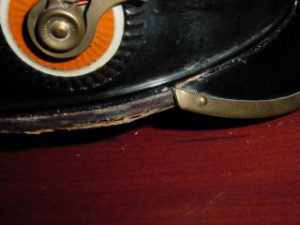 |
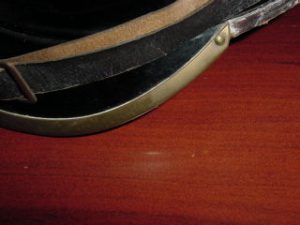 |
- The rear visor made out of thin steel factory issued with a rolled steel blackened trim. Just like the front visor the rear visor was inserted in the ridges of the bell. And then bent down, holding the liner in place and fixing the rear visor firmly in place.
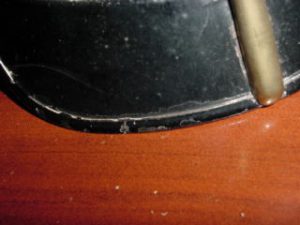 |
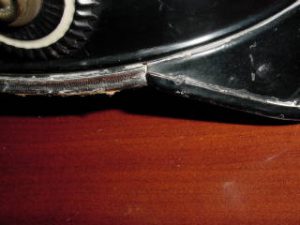 |
- The wappen. Made of brass, with a single tube loop to attach the wappen to the bell. This would allow for easy application through a matched hole in the bell. There is a slightly different system on this one example of a Saxon kit helmet. There are two holes drilled into the chest of this example wappen. It was believed that this might be a post war addition. The holes are too far apart for a landwehr cross. The only state wappen it could support is for Oldenburg. The holes are not even straight. But then this picture showed up:
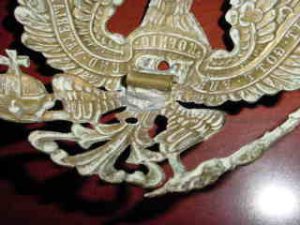 |
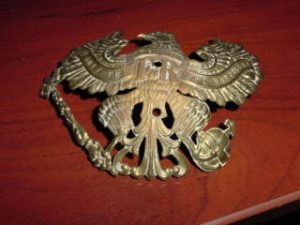 |
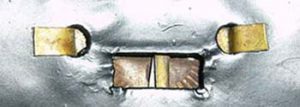
- The spike is made of brass and originally of two pieces joined into one in the factory, the spike and the base. The spike could be turned by hand. The base had faux dome studs. The spike was crimped to the flange on top of the bell.
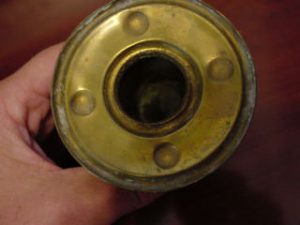 |
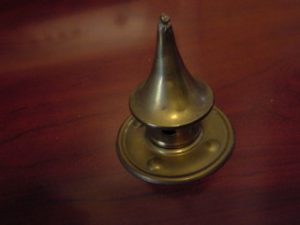 |
- A rear spine made of brass with two washers and square nuts for attachment to the bell through the two existing predrilled holes.
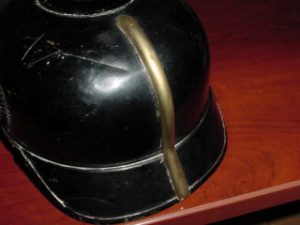 |
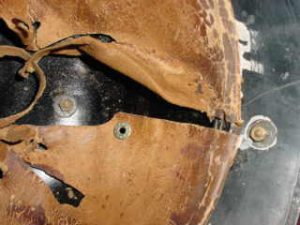 |
10&11 Two cockades in this example, a Prussian one on the left and a Reich’s cockade on the right. 48 mm with large holes and a slot to accept M91 posts.
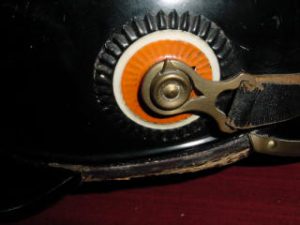 |
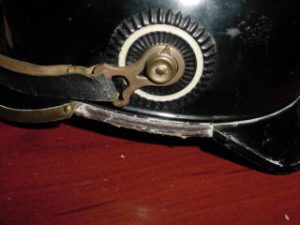 |
- A leather two buckle chin strap. This strap has obviously been stretched out to go over someone’s chin, just by pulling.
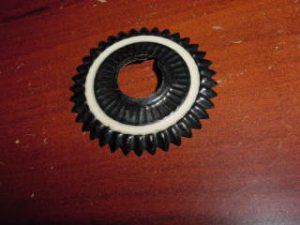 |
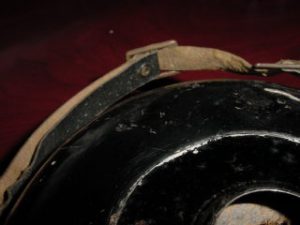 |
- A head pad to cushion the head from the bell and the nuts. I do not know what material this is made of. However, it is quite fragile and gives the impression of a cardboard paper. Similar head pad’s are found in the helmets of some cuirassiers to pad the wearer from the metal helmet.
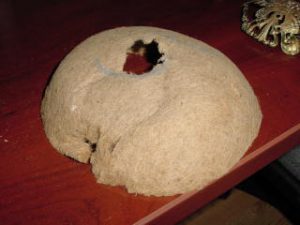 |
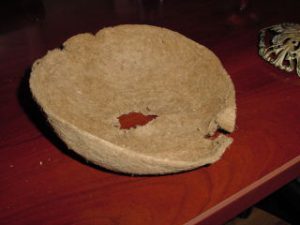 |
This example has provided a rare match between the soldiers of a very specific Abteilung and a specific type of metal helmet that we know was used in Prussia, Wurttemberg, Bavaria, Saxony and Baden. I’m sure there are errors in this but it is a fun explanation!

Recent Comments